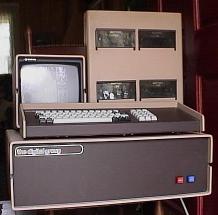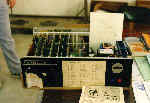
the digital group (lower case!) was an early microcomputer company based in Denver, Colorado. The corporation was founded in 1974 by Dr. Robert Suding, Dick Bemis, and their wives. Dr. Suding was the designer of most or all of the hardware. He wrote several articles about his designs which appeared in it appeared in various hobbyist magazines.
The MITS Altair bus (later known as S-100) was designed very closely around the 8080 and was relatively difficult to interface to other microprocessors. Dr. Suding designed a bus that was processor-independent, so customers would have a choice of processor. Because of this, the Digital Group bus actually has three different kinds of slots: CPU, memory, and I/O. CPU cards were available with the 8080, Z-80, 6800, and 6502, although the Z-80 was by far the most popular.
The Digital Group offered both kits and assembled systems, and quite an assortment of peripherals for their systems, including disk drives, a dot-matrix printer, and even a speech synthesizer. I saw a demo of the speech synthesizer at the 1977 Computer Corral in Denver; they had a version of the clasic Eliza program using the speech synthesizer to speak Eliza's responses.
One of the last products of The Digital Group was a system in which the monitor was built into the main system cabinet, called the "Bytemaster".
Some information on the history of The Digital Group and their demise in 1979 was published in the Reader to Reader column of issue 81 of The Computer Journal. Dr. Suding's own web site has a more authoritative account of the story of the Digital Group.
Until recently I only had a partial 6502-based system (boards and backplane, but no case or peripherals). Now I have a complete system. Here's a photo, courtesy of the seller, Antiques by Gisela (click for a larger view):
Note the Sanyo VM4209 9-inch monitor. These were very common amongst hobbyists at the time because they were fairly inexpensive yet had reasonable video quality. As far as I know, only the Digital Group went so far as to build a custom cabinet for it to match the rest of their system.
The tape drive unit (shown tilted up) has four Phi-Deck computer-controlled digital cassette decks , and was supported by the PHIMON operating system. The system used Group Coded Recording (GCR) to encode four data bits to five channel bits. The density was 1600 fcpi, and the tape read/write speed was 5 ips, for a transfer rate of 6400 bits per second. Search speed was 100 ips. Total storage was about 250 Kbytes on one side of a C30 cassette.
My system came equipped with the following boards:
| quantity | part number | description |
|---|---|---|
| 1 | DG-2002-B | standard motherboard, 1 CPU slot, 1 TVC slot, 3 memory slots, and 4 I/O slots (only 3 with connectors installed) |
| 1 | DG-1010-A | Z-80 CPU, 2.5 MHz, 2K on-board RAM, socket for 1702A 256-byte boot ROM |
| 2 | DG-32K-2 | 32K static RAM using 64 TMS4044NL RAM chips |
| 1 | DG-1002-A | parallel I/O |
| 1 | DG-1008-B | TVC (TV readout and Cassette) |
| 1 | DG-0006-B | Phi-Deck controller |
In addition, there was a small third party PC board attached via a ribbon cable to the EPROM socket of the CPU board. This small board is marked "ROM 4" and "RW SALES", and has four EPROM sockets. It is also wired to a rotary switch attached to the back panel of the computer. It appears to be a simple ROM switching device, allowing the selection of different bootstrap ROMs.
The Digital Group offered various standalone software and disk-based software. Their home grown operating systems included both the PHIMON operating system mentioned previously, and DISKMON for disk systems, both written by David Bryant. Other available operating systems included DISKMON, CP/M, OASIS, and MCOS (a CP/M-compatible OS by Microcom). They offered very little support for 6800 and 6502 CPUs, though. Some members of the 6502 Group, a user's group that meets every Tuesday in Golden, Colorado, ran locally-developed operating systems called FFS and Apex on their 6502-based Digital Group systems.
OASIS was a multi-user operating system by Phase One Systems, which has now merged with CET Software Incorporated. OASIS evolved into THEOS, which is now sold by THEOS Software Corporation. THEOS Software (GB), the distributor for Great Britain, has a THEOS Product History Page.
I've taken several photos of Digital Group boards, including a rare 6501 (not 6502!) processor board.

A Digital Group system that was displayed at the first
Vintage Computer Festival on the
table of The Computer Journal.
This photo is courtesy of James Willing of
Jim's Computer Garage.

Four Digital Group RAM cards. These appear to be the earlier 8K static RAM
cards based on the venerable 2102 chip.
This photo is courtesy of
Mark Metzler's
Online Computer History Bookstore/Museum.
See also my Phi-Deck page for ads for the tape drive.
There were a number of third-party products for use with Digital Group systems. R W Sales, Inc., founded by Rex Widmer, made quite a few items, which included better backplanes, CPU cards, memory cards, disk controllers, I/O processors, etc.
Rex Widmer died in a tragic automobile accident on January 14, 1999.
Just about everything, but especially:
 Back to my retrocomputing page
Back to my retrocomputing page
 Back to my home page
Back to my home page
Last updated April 25, 2004
Copyright 1998, 1999, 2000, 2003, 2004 Eric Smith